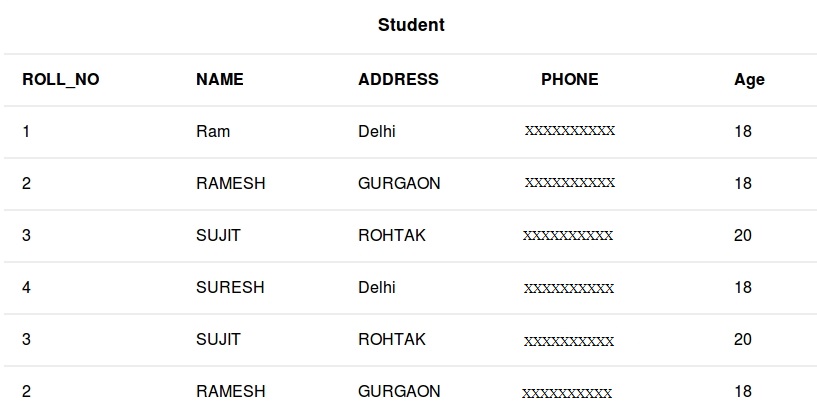SQL | WHERE Clause
- It is used to fetch data according to a particular criteria.
- WHERE keyword can also be used to filter data by matching patterns.
SELECT column1,column2 FROM table_name WHERE column_name operator value;
column1 , column2: fields int the table table_name: name of table column_name: name of field used for filtering the data operator: operation to be considered for filtering value: exact value or pattern to get related data in resultList of operators that can be used with where clause:
| operator | description |
| > | Greater Than |
| >= | Greater than or Equal to |
| < | Less Than |
| <= | Less than or Equal to |
| = | Equal to |
| <> | Not Equal to |
| BETWEEN | In an inclusive Range |
| LIKE | Search for a pattern |
| IN | To specify multiple possible values for a column |

Queries
- To fetch record of students with age equal to 20
SELECT * FROM Student WHERE Age=20;
Output:
ROLL_NO NAME ADDRESS PHONE Age 3 SUJIT ROHTAK XXXXXXXXXX 20 3 SUJIT ROHTAK XXXXXXXXXX 20
- To fetch Name and Address of students with ROLL_NO greater than 3
SELECT ROLL_NO,NAME,ADDRESS FROM Student WHERE ROLL_NO > 3;
Output:
ROLL_NO NAME ADDRESS 4 SURESH Delhi
BETWEEN operator
It is used to fetch filtered data in a given range inclusive of two values.Basic Syntax:
SELECT column1,column2 FROM table_name WHERE column_name BETWEEN value1 AND value2;
BETWEEN: operator namevalue1 AND value2: exact value from value1 to value2 to get related data in
result set.
Queries
- To fetch records of students where ROLL_NO is between 1 and 3 (inclusive)
SELECT * FROM Student WHERE ROLL_NO BETWEEN 1 AND 3;
Output:
ROLL_NO NAME ADDRESS PHONE Age 1 Ram Delhi XXXXXXXXXX 18 2 RAMESH GURGAON XXXXXXXXXX 18 3 SUJIT ROHTAK XXXXXXXXXX 20 3 SUJIT ROHTAK XXXXXXXXXX 20 2 RAMESH GURGAON XXXXXXXXXX 18
- To fetch NAME,ADDRESS of students where Age is between 20 and 30 (inclusive)
SELECT NAME,ADDRESS FROM Student WHERE Age BETWEEN 20 AND 30;
Output:
NAME ADDRESS SUJIT Rohtak SUJIT Rohtak
LIKE operator
It is used to fetch filtered data by searching for a particular pattern in where clause.Basic Syntax:
SELECT column1,column2 FROM table_name WHERE column_name LIKE pattern;
LIKE: operator namepattern: exact value extracted from the pattern to get related data in
result set.
Note: The character(s) in pattern are case sensitive.
Queries
- To fetch records of students where NAME starts with letter S.
SELECT * FROM Student WHERE NAME LIKE 'S%';
The ‘%'(wildcard) signifies the later characters here which can be of any length and
value.More about wildcards will be discussed in the later set.
Output:
ROLL_NO NAME ADDRESS PHONE Age 3 SUJIT ROHTAK XXXXXXXXXX 20 4 SURESH Delhi XXXXXXXXXX 18 3 SUJIT ROHTAK XXXXXXXXXX 20
- To fetch records of students where NAME contains the patter ‘AM’.
SELECT * FROM Student WHERE NAME LIKE '%AM%';
Output:
ROLL_NO NAME ADDRESS PHONE Age 1 Ram Delhi XXXXXXXXXX 18 2 RAMESH GURGAON XXXXXXXXXX 18 2 RAMESH GURGAON XXXXXXXXXX 18
IN operator
It is used to fetch filtered data same as fetched by ‘=’ operator
just the difference is that here we can specify multiple values for
which we can get the result set.Basic Syntax:
SELECT column1,column2 FROM table_name WHERE column_name IN (value1,value2,..);
IN: operator namevalue1,value2,..: exact value matching the values given and get related data in result set.
Queries
- To fetch NAME and ADDRESS of students where Age is 18 or 20.
SELECT NAME,ADDRESS FROM Student WHERE Age IN (18,20);
Output:
NAME ADDRESS Ram Delhi RAMESH GURGAON SUJIT ROHTAK SURESH Delhi SUJIT ROHTAK RAMESH GURGAON - To fetch records of students where ROLL_NO is 1 or 4.
SELECT * FROM Student WHERE ROLL_NO IN (1,4);
Output:
ROLL_NO NAME ADDRESS PHONE Age 1 Ram Delhi XXXXXXXXXX 18 4 SURESH Delhi XXXXXXXXXX 18
Please write comments if you find anything incorrect, or you want to share more information about the topic discussed above.